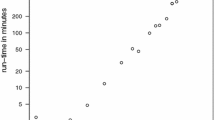Abstract
Random projections map a set of points in a high dimensional space to a lower dimensional one while approximately preserving all pairwise Euclidean distances. Although random projections are usually applied to numerical data, we show in this paper that they can be successfully applied to quadratic programming formulations over a set of linear inequality constraints. Instead of solving the higher-dimensional original problem, we solve the projected problem more efficiently. This yields a feasible solution of the original problem. We prove lower and upper bounds of this feasible solution w.r.t. the optimal objective function value of the original problem. We then discuss some computational results on randomly generated instances, as well as a variant of Markowitz’ portfolio problem. It turns out that our method can find good feasible solutions of very large instances.







Similar content being viewed by others
References
Achlioptas, D.: Database-friendly random projections: Johnson–Lindenstrauss with binary coins. J. Comput. Syst. Sci. 66, 671–687 (2003)
Ailon, N., Chazelle, B.: Approximate nearest neighbors and fast Johnson–Lindenstrauss lemma. In: Proceedings of the Symposium on the Theory Of Computing, Volume ’06 of STOC. ACM, Seattle (2006)
Boutsidis, C., Zouzias, A., Drineas, P.: Random projections for \(k\)-means clustering. In: Advances in Neural Information Processing Systems, NIPS. NIPS Foundation, La Jolla, pp. 298–306 (2010)
Dasgupta, S.: Experiments with random projection. In: Proceedings of the 16th Conference on Uncertainty in Artificial Intelligence, pp. 143–151. Morgan Kaufman, San Francisco (2000)
Dorn, W.: Duality in quadratic programming. Q. Appl. Math. 18(2), 155–162 (1960)
Gould, N., Toint, P.: A quadratic programming bibliography. In: Technical Report 2000–2001. RAL Numerical Analysis Group (2001)
IBM: ILOG CPLEX 12.8 User’s Manual. IBM (2017)
Indyk, P., Motwani, R.: Approximate nearest neighbors: towards removing the curse of dimensionality. In: Proceedings of the Symposium on the Theory Of Computing, Volume 30 of STOC, pp. 604–613. ACM, New York (1998)
Indyk, P., Naor, A.: Nearest neighbor preserving embeddings. ACM Trans. Algorithms 3(3), 31 (2007)
Johnson, W., Lindenstrauss, J.: Extensions of Lipschitz mappings into a Hilbert space. In: Hedlund, G. (ed.) Conference in Modern Analysis and Probability. Contemporary Mathematics, vol. 26, pp. 189–206. AMS, Providence, RI (1984)
Kane, D., Nelson, J.: Sparser Johnson–Lindenstrauss transforms. J. ACM 61(1), 4 (2014)
Liberti, L., Vu, K.: Barvinok’s naive algorithm in distance geometry. Oper. Res. Lett. 46, 476–481 (2018)
Markowitz, H.: Portfolio selection. J. Finance 7(1), 77–91 (1952)
May, J., Smith, R.: Random polytopes: their definition, generation and aggregate properties. Math. Program. 24, 39–54 (1982)
Paul, S., Boutsidis, C., Magdon-Ismail, M., Drineas, P.: Random projections for linear support vector machines. ACM Trans Knowl Discov Data 8(4), 22:1–22:25 (2014)
Pilanci, M., Wainwright, M.: Randomized sketches of convex programs with sharp guarantees. In: International Symposium on Information Theory (ISIT), pp. 921–925. IEEE, Piscataway (2014)
Pilanci, M., Wainwright, M.: Newton sketch: a linear time optimization algorithm with linear-quadratic convergence. SIAM J. Optim. 27(1), 205–245 (2017)
Shim, J.: A survey of quadratic programming applications to business and economics. Int. J. Syst. Sci. 14(1), 105–115 (1983)
Vavasis, S.: Quadratic programming is in NP. Inf. Process. Lett. 36, 73–77 (1990)
Vempala, S.: The random projection method. In: Number 65 in DIMACS Series in Discrete Mathematics and Theoretical Computer Science. AMS, Providence, RI (2004)
Venkatasubramanian, S., Wang, Q.: The Johnson–Lindenstrauss transform: an empirical study. In: Algorithm Engineering and Experiments, Volume 13 of ALENEX, pp. 164–173. SIAM, Providence, RI (2011)
Vershynin, R.: High-dimensional Probability. CUP, Cambridge (2018)
Vu, K., Poirion, P.-L., D’Ambrosio, C., Liberti, L.: Random projections for quadratic programs over a Euclidean ball. In: Lodi, A., et al. (eds.) Integer Programming and Combinatorial Optimization (IPCO). LNCS, vol. 11480, pp. 442–452. Springer, New York (2019)
Vu, K., Poirion, P.-L., Liberti, L.: Random projections for linear programming. Math. Oper. Res. 43(4), 1051–1071 (2018)
Vu, K., Poirion, P.-L., Liberti, L.: Gaussian random projections for Euclidean membership problems. Discrete Appl. Math. 253, 93–102 (2019)
Woodruff, D.: Sketching as a tool for linear algebra. Found. Trends Theor. Comput. Sci. 10(1–2), 1–157 (2014)
Yang, J., Meng, X., Mahoney, M.: Quantile regression for large-scale applications. SIAM J. Sci. Comput. 36(5), S78–S110 (2014)
Zhang, L., Mahdavi, M., Jin, R., Yang, T., Zhu, S.: Recovering the optimal solution by dual random projection. In: Shalev-Shwartz S., Steinwart I. (eds) Conference on Learning Theory (COLT), Volume 30 of Proceedings of Machine Learning Research, pp. 135–157. \(\langle \)jmlr.org\(\rangle \) (2013)
Acknowledgements
We are grateful to two anonymous referees for many excellent suggestions and insights.
Author information
Authors and Affiliations
Corresponding author
Additional information
Publisher's Note
Springer Nature remains neutral with regard to jurisdictional claims in published maps and institutional affiliations.
This paper has received Funding from the European Union’s Horizon 2020 research and innovation programme under the Marie Sklodowska-Curie Grant Agreement n. 764759 “MINOA”
Rights and permissions
About this article
Cite this article
D’Ambrosio, C., Liberti, L., Poirion, PL. et al. Random projections for quadratic programs. Math. Program. 183, 619–647 (2020). https://doi.org/10.1007/s10107-020-01517-x
Received:
Accepted:
Published:
Issue Date:
DOI: https://doi.org/10.1007/s10107-020-01517-x
Keywords
- Nonlinear programming
- Polynomial optimization
- Large-scale optimization
- Approximation
- Johnson–Lindenstrauss lemma




